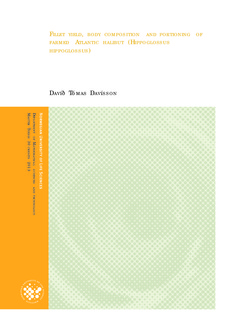| dc.description.abstract | The aim of the study was to estimate the fillet yield (before and after skinning) and proximal composition in farmed Atlantic halibut (Hippoglossus hippoglossus) as well as portioning the fillets and calculate their corresponding yields. This was performed not only to assess fillet yields but also as an early feasibility study to see whether portioning them could increase the value of the fillets. Fillet yield and body composition of Atlantic halibut was estimated from 12 fish in five different size categories harvested during winter (February 2013) and spring (April 2013). Four different methods where used to divide the fillets from winter harvested Atlantic halibut into two portions. The fillets of the spring harvested fish where cut into portions using two different methods. One method consisted of cutting out of the fillet a large, boneless and skinless portion that would have an even shape. Meanwhile, the remaining portions of the fillets where left large enough to be usable in making sashimi (Balanced method). The other method cut out an evenly shaped skinless, boneless portion that was as large as possible leaving the remaining pieces so small that they could only be used as cut-offs (MaxA method). The smaller portions from the balanced method were used to make sashimi. Two methods were used to cut the portions into sashimi, traditional and myotomal. The traditional method involved cutting long thin slices against the grain get the sashimi pieces. The myotomal method was performed by running the knife along the myosepta so that each sashimi piece consisted of mostly one myotome.
The highest fillet yield was in the largest fish (7-9kg) harvested in winter, 59±4% of gutted weight, (g.w), while the lowest yield came from the 4-5kg fish (50,6 % g.w.) that was harvested in spring. The lower yield in the smaller fish was at least partly explained by the proportionally larger head the smaller fish had (23,5±0,6% g.w.) when compared to the head size of larger fish (14,3±2,0 % g.w.). The fish harvested in winter had higher yields than fish harvested in spring (55,2± 0,3-58,8±3,5% g.w. and 50,6-55,0% g.w., respectively). Skinning the fillets decreased the yield by about 5-6% except in the 7-9kg spring harvested fish where the skin portion was a much higher (8,2% g.w.). The yield of the Dorsal right fillets was always highest and it was always lowest in the Ventral left fillet (15,5-16,8±2,4% g.w. and 8,6±0,41%-14,5±0,9% g.w., respectively).
The most successful method used to divide up the winter halibut fillets was subjectively cutting the fillets so that each part would be as evenly shaped as possible. The yields from these two portions were 18,1±3,0% g.w. and 9,8±2,5% g.w. for the dorsal fillets and 14,6±1,6% g.w and 4,5±1,1% g.w for the ventral fillets.
When the spring fillets halibuts were portioned, the Balanced method resulted in three distinct type of portions: (1) a large evenly shaped boneless skinless portion (25,2%-26,2% g.w.), (2) a smaller portion
5
suitable for making sashimi (9,3-9,8% g.w.), and (3) the remains of the fillets that could only be used as cut-offs (6,4-9,8% g.w) . The MaxA method produced a larger evenly shaped boneless, skinless portion (28,9±2,1-31,7% g.w.), but the remaining portions (12-12,09±1,2% g.w.) where only suitable for use as cut-offs. In the Balanced method the large boneless, skinless fillet was always smallest in the dorsal left fillet (4,4-8% g.w) and largest in the dorsal right fillet (8,3-11,6%). In the MaxA method the large boneless, skinless portion was smallest in the ventral left fillets (4,9±0,2% g.w.) and largest in the dorsal right fillets (10,4±0,1% g.w.)
No significant differences in weight or dimensions were found between the sashimi cut traditionally or using the myotomal method. Large variation was found in the amount of sashimi pieces that could be obtained from each fillet (20,3±4,3), most likely due to the large size variations in the fillets.
The results in this study indicate that it could well be possible to increase the value of the fillets using portioning, especially in the 7-9kg fish that is harvested during winter, and that larger fish is expected to have higher yield. | no_NO |
